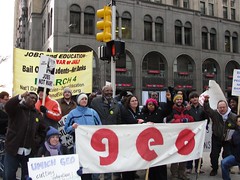
Detroit participants in the March 4 demonstration and rally to defend public education. The demonstration called for the restoration of all funding cuts in public education and an end to privatization.
Originally uploaded by Pan-African News Wire File Photos
Minority students rally in crisis
Demographic changes show as non-whites lead protests against education funding cuts
ERIC GORSK
Associated Press
Irvine, Calif. -- If campus activism still brings to mind peace signs, a sea of white faces and liberal strongholds like Berkeley, meet Jesse Cheng.
Cheng is a third-year Asian-American studies major at the University of California, Irvine, a campus less than five decades old in the middle of Orange County, a place of strip malls and subdivisions that gave birth to the ultraconservative John Birch Society.
Comfortable talking with both administrators and anarchists, Cheng is a presence at protests but avoids getting arrested. He doesn't want to put his graduation at risk or upset his mother, who worked hard to get him here and worries for his safety because she witnessed what happened to dissidents in her native China.
Cheng is part of a growing movement of minority students rallying around a new cause -- fighting a budget crisis that's undermining access to higher education at a time when students of color have become a stronger demographic force.
"For a lot of students of color, this is our dream and our hope -- to get to college," said Cheng, who is about to start a one-year term representing students from all 10 University of California campuses on the system's board of regents. "We never thought we'd make it and we're here. And we're not going to give it up so easily."
While talk about a rebirth of student activism surfaces every few years whenever sweatshop labor or some other cause draws a decent crowd, some observers believe organizing around threats to higher education has the potential to grow into something big, maybe even a national movement.
But a visit to a developing activist hotspot like UC-Irvine -- where tensions have run high this year over everything from student tuition hikes to gender-neutral bathrooms and Middle East politics -- illustrate the challenges involved.
The increased diversity of students, many of them the first in their families to attend college, is both a strength and a liability. Splits have emerged over tactics and agendas, making coalition-building more challenging than ever.
"It's a very diverse group, a lot of students of color, which makes it more difficult to organize," said Alejandra Ocasio, a fourth-year student from San Diego active in a Hispanic campus student association. "We all have our own interests. It can be difficult to reconcile those things."
At 27,000-student UC-Irvine, the scene includes a Pakistani-American working behind the scenes on budget issues as her own financial aid disappears, a Filipino-American struggling to shake fellow Asian students from political apathy and a gay African-American activist who thinks the focus on student fees obscures larger problems like the evils of capitalism.
'Free-speech zone'
The fact students of color are at the forefront of campus protests marks a shift, said Arthur Levine, a former president of Teachers College at Columbia University in New York who has studied student activism.
"In the past, minorities have tended to provide leadership for the minority protests," Levine said. "Now they've moved to center stage."
On a recent morning, Cheng led a quick tour of activism at UC-Irvine.
Here, he said, is the designated "free-speech zone" in front of the administration building.
About 1,000 people, a big crowd for a campus often maligned as apathetic, crowded onto the steps and filled an area between two flagpoles on March 4, a national day of college student demonstrations against tuition hikes and program cuts.
"Everyone was silent," Cheng recalled. "It felt more like a lecture. I mean, it was a great moment -- a teaching moment. But it wasn't a punch-you-in-the-face kind of deal."
Therein lies one challenge to organizing a movement around budget issues: a massive fee increase like the one UC students are facing this year is painful and personal. But it's not as visceral as, say, the Vietnam War, which was a matter of life and death for students of the '60s and '70s facing the draft.
"Our crisis is different -- and our demographics are very different," Cheng said.
Nationwide impact
The March 4 Day of Action for Public Education began as a California-only event, a sequel to fall demonstrations against the state Board of Regents' decision to boost UC undergraduate fees, the equivalent of tuition this fall by 32 percent for in-state students. The $2,500 fee hike brings UC education fees to about $10,300, plus about another $1,000 for campus-based charges.
Despite no real organization, the protest spread nationwide. Most demonstrations were peaceful, although protesters threw punches and ice chunks in Milwaukee and shut down a major freeway in Oakland, Calif., during rush-hour traffic.
It's no accident that California, with its ethnic diversity and severe budget problems, is the epicenter of revived activism, said Angus Johnston, a historian of student activism who teaches at the City University of New York.
No comments:
Post a Comment